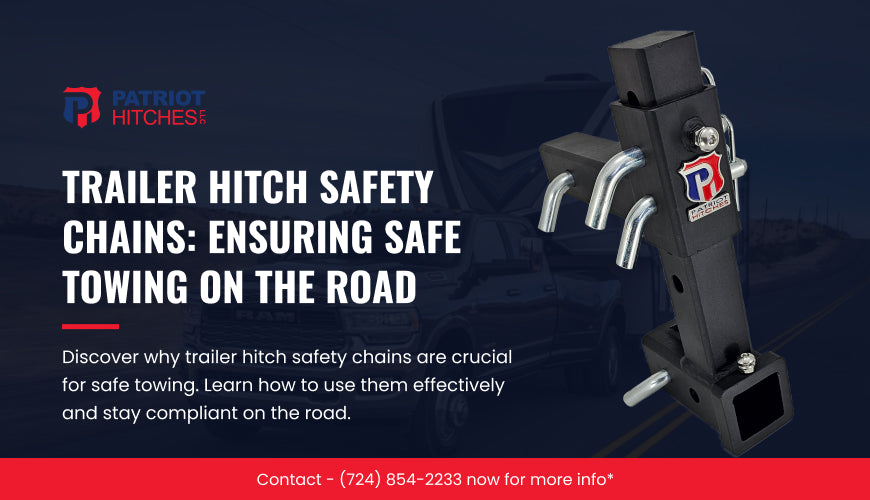Trailer Hitch Safety Chains: Ensuring Safe Towing on the Road
Trailer Hitch Safety Chains: Ensuring Safe Towing on the Road
SCOTT MCCUSKEY @

Trailer hitch safety chains are crucial components of any towing setup, providing a critical backup in case the trailer becomes detached from the towing vehicle. This comprehensive guide explores why safety chains are important trailer hitch accessories, how to use them properly, and essential tips for maximizing their effectiveness.
Why Are Trailer Hitch Safety Chains Important?
Safety chains serve as a secondary connection between the towing vehicle and the trailer's hitch. Their primary purpose is to prevent the trailer from completely separating from the towing vehicle in the event of a hitch failure or detachment. This is critical for ensuring the safety of both the vehicle occupants and other road users.
-
Preventing Runaway Trailers:
In the unfortunate event of a hitch failure, safety chains keep the trailer connected to the towing vehicle. This prevents the trailer from becoming a runaway hazard on the road, which can lead to accidents, damage, or injury. -
Maintaining Control:
Safety chains help maintain control over the trailer during sudden stops or maneuvers. They reduce the risk of the trailer swaying or jackknifing, which can occur if the trailer becomes detached unexpectedly. -
Legal Requirement:
In many regions, using safety chains is a legal requirement when towing trailers. Compliance with these regulations not only ensures safety but also avoids potential fines or legal consequences.
How to Properly Use Trailer Hitch Safety Chains
Proper usage of safety chains involves more than just attaching them to the hitch and trailer. It requires attention to detail and adherence to best practices to maximize their effectiveness.
1. Crossing the Chains
When attaching safety chains, it's crucial to cross them under the trailer tongue before connecting them to the hitch receiver. This crossing creates a cradle shape that helps support the trailer tongue in case of a hitch failure. It also prevents the tongue from dropping to the ground, minimizing potential damage.
2. Maintaining Proper Length
Safety chains should be neither too loose nor too tight. Aim for enough slack to allow for turns and maneuvers without binding, but not so much slack that the chains drag on the ground or become tangled. Adjust the length accordingly before setting off on your journey.
3. Securing the Connections
Ensure that the safety chains are securely attached to both the trailer and the hitch receiver. Use reliable attachment points and strong hardware to prevent accidental detachment. Regularly check the connections during stops to confirm they remain secure throughout the journey.
4. Choosing the Right Chains
Select safety chains that are strong enough to handle the weight of your trailer. Consider the Gross Vehicle Weight Rating (GVWR) of the trailer and choose chains with a capacity that exceeds this weight. Chains should be made from durable materials like steel and feature sturdy hooks or connectors that resist bending or breaking under stress.
5. Regular Inspection and Maintenance
Regularly inspect the safety chains for signs of wear, corrosion, or damage. Replace any chains that show these signs to ensure reliability during towing. Lubricate the hooks or connectors periodically to prevent rust and ensure smooth operation.
Tips for Maximizing Safety with Trailer Hitch Safety Chains
1. Check State and Local Regulations
Before towing, familiarize yourself with the towing regulations in your state or country. Ensure compliance with safety chain requirements, including length, strength, and attachment methods. Failure to comply could result in fines or penalties.
2. Practice Safe Towing Habits
Adopt safe towing habits, such as maintaining a safe distance from other vehicles, avoiding sudden maneuvers, and using mirrors to monitor the trailer's behavior. These habits complement the use of safety chains and enhance overall towing safety.
3. Educate All Users
Ensure that everyone involved in towing understands the importance of safety chains and how to use them correctly. Educate drivers and passengers on emergency procedures in case of a trailer detachment, emphasizing the importance of staying clear of the trailer's path.
4. Consider Additional Safety Features
In addition to safety chains, consider investing in other safety features such as trailer brake controllers, sway control devices, and tire pressure monitoring systems. These enhancements further enhance towing safety and provide peace of mind during your travels.
Conclusion
Trailer hitch safety chains are indispensable safety features for any towing setup. They provide a crucial backup connection between the towing vehicle and trailer, preventing runaway trailers and enhancing overall towing safety. By understanding why safety chains are important, how to use them properly, and implementing best practices, you can ensure a safe and enjoyable towing experience on the road.
Prioritize safety by properly using and maintaining trailer hitch safety chains, and always comply with towing regulations to mitigate risks and maximize safety for yourself and others on the road. Safe towing starts with secure connections—make trailer hitch safety chains a fundamental part of your towing routine.




